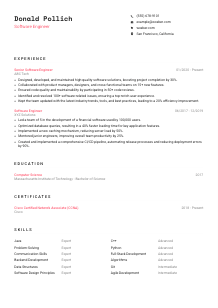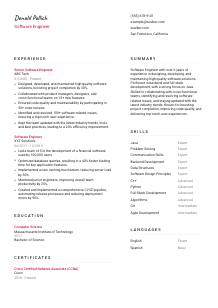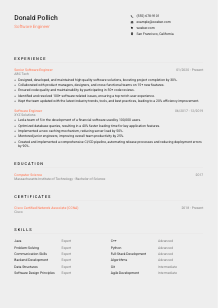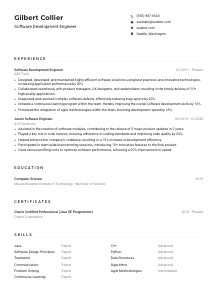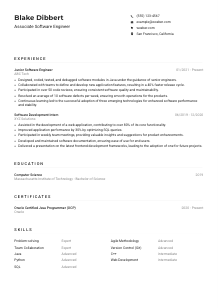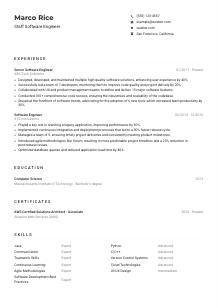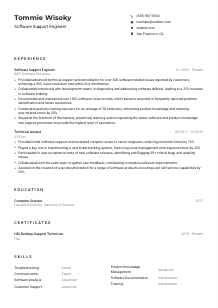Software Engineer CV Example
Crafting code, but your CV seems like a syntax error? Dive into this Software Engineer CV example, engineered with Wozber free CV builder. It illustrates how you can seamlessly integrate your programming prowess with job needs, so your career path never encounters a runtime bug!
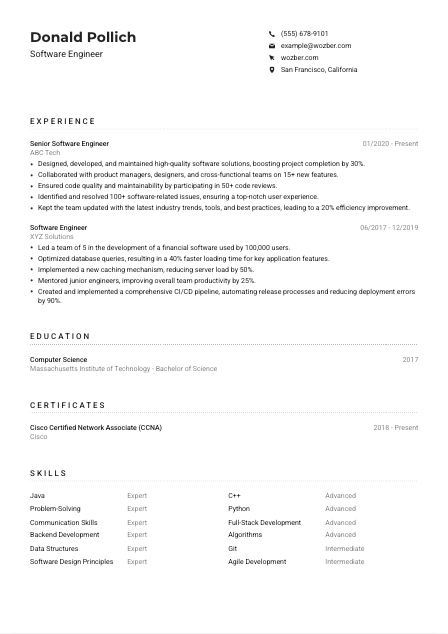
How to write a Software Engineer CV?
Hello, aspiring Software Engineer! The tech world is a chessboard, and your CV is your opening move. It's not just a document; it's a programming statement that says 'I am the function you need.' In the highly competitive tech job market, standing out is crucial. This guide, powered by Wozber's free CV builder, is designed to arm you with the strategies needed to tailor your CV precisely to your dream role.
Ready to compile your success? Let's embark on this journey to encode your CV into an offer-letter magnet!
Personal Details
A well-structured Personal Details section sets the tone for your CV. It's where you initialize your variables – your contact info. Let's break down how to fine-tune this section for a Software Engineer position, ensuring it compiles cleanly with job requirements.
1. Declare Your Name Clearly
Think of your name as the function declaration. It should stand out as the main identifier in your CV, so choose a clear, readable font and slightly upscale the typography. This ensures your name is the first thing the hiring manager notices, much like a well-named function in a code.
2. Match the Job Title
Including the job title from the job description right below your name acts like a comment that clarifies your purpose. For the Software Engineer role, echoing the job title immediately informs the hiring manager about the position you're targeting. This is particularly helpful for ATS optimisation.
3. Clear and Concise Contact Information
Ensure your contact details are bug-free. Include a phone number without typos and a professional email address that sticks to a firstname.lastname@email.com format. Today, a LinkedIn profile acts as a repository of your professional journey; include it if it mirrors your CV and is kept up-to-date.
4. Specify Your Location
Since the job spec calls for the candidate to be located in "San Francisco, California," specifying your location matches this requirement directly. It signals to the hiring manager that you're already in the right heap space, eliminating any concerns about relocation right from the get-go.
5. Exclude the Unnecessary
Keep your personal details streamlined by leaving out age, marital status, or photo unless they are explicitly required. In a world where code needs to be lean and efficient, so too should your personal section only include what's necessary, safeguarding against unconscious bias.
Takeaway
Consider the Personal Details section as the header of your CV; it's where you define the metadata about yourself. Keep it professional, concise, and tailored to the Software Engineer role you're eyeing. You're initiating the first handshake with your potential employer here; make it count.





Experience
Your Experience section is where you demonstrate your impact and value as a Software Engineer. Reflecting on your debugging journey can make you irresistible to recruiters. Let's methodically iterate through each position you've held, constructing a narrative that convincingly aligns with the job you desire.
- Designed, developed, and maintained high‑quality software solutions, boosting project completion by 30%.
- Collaborated with product managers, designers, and cross‑functional teams on 15+ new features.
- Ensured code quality and maintainability by participating in 50+ code reviews.
- Identified and resolved 100+ software‑related issues, ensuring a top‑notch user experience.
- Kept the team updated with the latest industry trends, tools, and best practices, leading to a 20% efficiency improvement.
- Led a team of 5 in the development of a financial software used by 100,000 users.
- Optimised database queries, resulting in a 40% faster loading time for key application features.
- Implemented a new caching mechanism, reducing server load by 50%.
- Mentored junior engineers, improving overall team productivity by 25%.
- Created and implemented a comprehensive CI/CD pipeline, automating release processes and reducing deployment errors by 90%.
1. Parse the Job Requirements
Just like breaking down a project specification before coding begins, start by dissecting the job listing for key experiences. Highlight these requirements to ensure your CV speaks directly to the needs of the role, such as "designed, developed, and maintained high-quality software solutions" and collaborative work with cross-functional teams.
2. Apply a Method to Your History
Organize your experience in a clean, readable manner, starting with the most recent. Include your role, the company's name, and the duration of your employment. This structure helps the hiring manager navigate your professional timeline with ease, much like clear documentation aids in code comprehension.
3. Code Your Achievements
For each role, articulate your responsibilities and achievements in a way that mirrors the job requirements. Use active language and structure your statements like well-commented code, making your contributions easy to understand at a glance. Where possible, quantify your achievements – numbers often speak louder than words in our field.
4. Quantify Your Success
Whenever possible, include metrics. Just as test cases quantify code quality, numbers in your CV quantify your contributions. For example, 'Boosted project completion by 30%,' gives a tangible measure of your impact.
5. Focus on Relevance
Your experience with the office ping-pong championship might be impressive, but save it for the interview banter. Keep your experience section tightly aligned with the specific Software Engineer role, ensuring every bullet point addresses a requirement or desired skill from the job description.
Takeaway
Imagine your experience section as a repository of your successes. This is where you demonstrate that not only have you been there and done that, but you've excelled along the way. By carefully constructing this section to reflect the job's needs, you invite the hiring manager to envision you excelling in the role at their company. Remember, your CV is your code – make it elegant, efficient, and error-free.
Education
While it might seem straightforward, the Education section holds the foundational classes of your career's source code. Let's encrypt this section in a way that makes hiring managers see you as an asset from the start.
1. Identify Key Requirements
Scan the job descriptions for mentioned degrees or fields of study. In this case, a "Bachelor's degree in Computer Science, Software Engineering, or a related technical field," is specified. This requirement becomes the primary function of your education section.
2. Maintain a Structured Stack
Keep this section logically ordered and easy to navigate: degree, field, institution, and graduation date. Much like maintaining clean code, a clear structure in your Education section helps hiring managers understand your qualifications quickly.
3. Parameterize Your Degree Information
If the job asks for a specific degree, specify yours accordingly as long as it aligns. For example, listing a "Bachelor of Science in Computer Science" directly from MIT mirrors the required qualification perfectly and speaks volumes about your technical foundation.
4. Include Additional Headers
For roles requiring specific knowledge areas, listing relevant courses or projects (especially in early career stages) can be beneficial. While not necessary for our Software Engineer since the degree encompasses the technical baseline, this tip can boost junior developers' CVs.
5. Add Relevant Educational Metadata
Should you have any accolades, relevant coursework, or projects that align closely with the job description, include them. For more experienced roles, focus on education that directly contributes to your prowess as a Software Engineer, keeping ancillary achievements to a minimum.
Takeaway
Your Education section underpins your technical credentials, much like foundational libraries support a complex application. Align it with the role's requirements, highlighting your academic achievements that resonate most with the position you seek. Through this, you demonstrate the robustness of your technical grounding and readiness to tackle the challenges of the job.
Certificates
Certificates are like added libraries to your CV, enhancing your application's functionality. Let's navigate through displaying your continuous learning and specializations that beam like badges of honor on your digital lapel.
1. Extract Necessary Credentials
First, identify any certifications explicitly mentioned in the job posting. Our Software Engineer position did not specify, but including relevant certifications like 'Cisco Certified Network Associate (CCNA),' shows a commitment to enhancing your skill set and keeps you competitive.
2. Focus on Relevant Certifications
While it's tempting to list all your certificates, highlight those that strengthen your application for the Software Engineer role. Prioritize quality over quantity, ensuring that each certificate you mention adds value and relevance to your candidacy for the position.
3. Time-stamp Your Achievements
For certifications with expiration dates or those recently acquired, including the date showcases the currency of your skills. In a field as dynamic as software engineering, current certifications indicate that you're up-to-date with the latest technologies and methodologies.
4. Regularly Update Your Certifications
Like constantly refactoring code, keep your certifications section refreshed. In the fast-paced tech environment, new certifications can significantly enhance your profile, demonstrating your dedication to professional growth and mastery of the latest tech trends.
Takeaway
Certificates in your CV signal to hiring managers that you're not just resting on your laurels but actively boosting your tech stack. Like choosing the right libraries for a project, selecting certifications that spotlight your skills and dedication to the craft can give you an edge in the job market. Stay curious, stay learning, and let your CV reflect your journey of continuous improvement.
Skills
The Skills section of your CV is like a quick reference guide, offering a glimpse into your professional toolkit. Let's navigate the process of aligning your skill set with the role's expectations, ensuring your technical prowess and soft skills gleam through.
1. Parse the Job Listing for Skills
Begin by meticulously reviewing the job description, extracting both the implied and explicitly stated skills required. For a Software Engineer role, technical skills like proficiency in Java or Python are often listed alongside soft skills such as strong problem-solving and communication.
2. Curate a Focused List
Once you've identified the essential skills, compile a list that mirrors the job description. Aim for a balanced mix of technical proficiencies like "Backend Development" and soft skills like "Communication Skills," ensuring each skill you list demonstrates your fit for the role.
3. Prioritize Clarity and Relevance
Resist the temptation to list every skill under the sun. Focus on relevance and clarity, aligning your expertise with what's sought in the Software Engineer position. Prioritize the skills that make you stand out as a prime candidate, ensuring they are clearly articulated and easy to find.
Takeaway
Your Skills section is a concise showcase of what you bring to the table. Approach it as your chance to make a mark, highlighting how your unique capabilities can contribute to the team and the role at hand. With the right blend of hard and soft skills, you're demonstrating not just your technical acumen but also your holistic fit for the Software Engineer role. Keep refining, keep honing, and let your skills section speak volumes.
Languages
In the interconnected world of software development, the ability to communicate across borders can be a superpower. This section will guide you in showcasing your linguistic skills, turning them into a unique value proposition for global roles.
1. Audit the Job Specs for Language Requirements
Start by identifying if specific languages are preferred or required. Our Software Engineer position demands fluency in English, so ensure this language is prominently listed and your proficiency level is clear.
2. Lead with Essential Languages
List languages in order of relevance to the job, leading with those specifically mentioned in the job description. Indicating your fluency in English as "Fluent" directly satisfies one of the Software Engineer role's critical requirements.
3. Catalogue Additional Languages
Including other languages can distinguish you in the hiring process, especially in companies with a global reach. Showcase your multilingual capabilities, as it demonstrates adaptability and a readiness to engage in diverse work environments.
4. Be Honest About Your Level
Accuracy is key. Use clear, universally understood terms to describe your proficiency: Native, Fluent, Intermediate, and Basic. This honesty ensures realistic expectations and demonstrates your integrity.
5. Evaluate the International Scope
For roles that value or demand international collaboration, your multilingual skills could be your ticket in. If the job entails work beyond regional borders, highlighting your ability to communicate in multiple languages could significantly enhance your candidacy.
Takeaway
Your ability to communicate in multiple languages is more than just a line on a CV; it's a testament to your capability to operate in a globally connected world. Even if proficiency is basic, every language you learn opens new doors. Present your linguistic prowess boldly, and consider it a bridge to broader opportunities. Continue to enrich your linguistic portfolio, and let it propel you towards an exciting, diverse career path.
Summary
A captivating Summary section operates much like a compact, powerful function – it encapsulates your professional essence. Here's how to craft a summary that speaks volumes in just a few lines, echoing the job specifications and your unique qualifications.
1. Decode the Job Essence
Take a deep dive into the job listing and internalize the core requirements and preferred qualifications. This understanding is crucial to tailor your summary in a manner that resonates with the job, mirroring phrases like "experience in designing, developing, and maintaining high-quality software solutions".
2. Initialize with a Strong Introduction
Start with a clear statement that encapsulates who you are in the professional spectrum – a Software Engineer with a focus on backend and full-stack development. This introduction sets the stage and invites the hiring manager to explore the depth of your experience.
3. Loop Through Your Achievements
Highlight your career high points that are most relevant to the job at hand. Point to your proficiency in key programming languages, your knack for solving complex problems, and your ability to collaborate effectively. This succinctly communicates what you bring to the role.
4. Keep It Tightly Packed
The art of a great summary is in its brevity and punch. Aim for 3-5 lines that pack a strong statement about your professional identity, mirroring the efficiency and elegance of well-written code. This teaser sets the tone for the subsequent deep dive into your CV.
Takeaway
Your Summary is the powerful first impression, your CV's handshake with the hiring manager. Craft it with care, reflecting on your fit for the Software Engineer role while maintaining conciseness and impact. This opening statement should intrigue, inform, and invite further reading, paving the way for the detailed story that unfolds in the pages that follow. Here's to writing the first line of your next big opportunity!
Deploying Your CV into the Tech World
Congratulations on making it through this guide! With these tips and strategies, you are now equipped to write a Software Engineer CV that not only ticks all the boxes but stands out in a pile. The free CV builder offered by Wozber is an excellent starting point for crafting an ATS-compliant CV that reflects your unique skills and experiences. Whether you're using an ATS-friendly CV template or customizing one to fit your style, remember to run your final draft through an ATS CV scanner to ensure optimisation.
The world of technology is vast and full of opportunities. With the right CV in hand, you are ready to embark on an exciting journey toward your dream job. May the code be with you!

- Bachelor's degree in Computer Science, Software Engineering, or a related technical field.
- Minimum of 3 years of professional software development experience, with a strong focus on backend or full-stack development.
- Proficiency in at least one modern programming language such as Java, C++, or Python.
- Solid understanding of data structures, algorithms, and software design principles.
- Strong problem-solving and communication skills.
- The position demands fluency in English.
- Must be located in San Francisco, California.
- Design, develop, and maintain high-quality software solutions according to project requirements.
- Collaborate with product managers, designers, and cross-functional teams to define, design, and ship new features.
- Participate in code reviews, ensuring code quality and maintainability.
- Identify and resolve software-related issues and bugs, ensuring top-notch performance and user experience.
- Stay updated with the latest industry trends, tools, and best practices, and share knowledge with the team.





